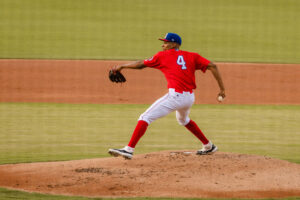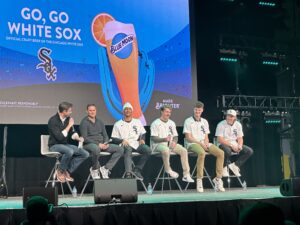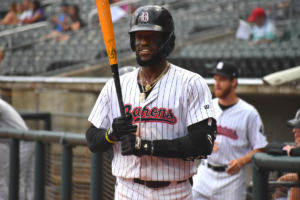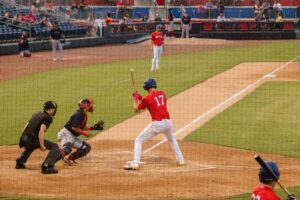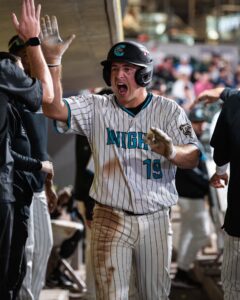Just Missed – Prospects outside the Preseason Top 30
Welcome to Rankings Week, 2019! Twice a year, we rank the top prospects in the White Sox system. The schedule of events looks like this:
- Tuesday: The Just Missed article (this one)
- Wednesday: Prospects ranked #16-30, with capsules
- Thursday: The FULL LIST, with capsules for #1-15
- Friday: Writers’ roundtable discussion of the rankings
The White Sox farm system is still one of the deepest in baseball. Since our last list in August, only one ranked player has lost eligibility (Alex Call, who was traded). In the meantime we’ve had 1-2 months of regular minor league seasons and some off-season leagues and all the looks gained from those, as well as a handful of off-season signings to take in.
That brings us to this list: 15 players who did not make the top 30 this cycle, but who our writers discussed and considered for it. The depth of talent on the farm means that even these players (and probably more) are legitimate prospects. These are prospects on the edge of the radar, and history says some of them will end up contributing value down the line.
NOTE: Players are not necessarily listed in a specific order, though the first few listed were the ones closest to making it…

RHP Zach Thompson
Thompson is a graduate of the White Sox school of “Let’s work this kinda raw probable reliever as a starter for a while to accelerate his development.” In 2018 and fully into a bullpen role, the 6’7″ right-hander posted some strong numbers (6.8 H/9, 3.5 BB/9, 9/1 K/9) split evenly across A+ and AA during his age 24 campaign. He then went to the AFL where he posted similarly solid stats in front of scouts aplenty, drawing positive reviews of both his curve and cutter. He was also the biggest nail-biter for the White Sox front office when the Rule 5 Draft came around, but it turns out he was able to stick and none other than GM Rick Hahn feels there’s a chance he contributes to the big league club in 2019. Zach just barely missed our top 30, and perhaps we will come to regret that as the season goes on.

LHP Caleb Frare
Another reliever who just missed the back end of our list, this lefty actually made his MLB debut in 2018 but is technically still a prospect. His seven innings of work with the Sox produced flashes of success and some struggles, but he struck out 19 batters in 12.2 IP with AAA Charlotte before then to earn a look. Acquired in July from the Yankees in exchange for $1.5M in international rights-to-spend, Frare has consistently been death on lefty bats, relying mostly on a mid-90’s late-moving fastball and a slider that has improved in recent years (see that link for sources and more scouting details). A LOOGY role is likely which limits his overall value, but there’s a good chance he will be effective in that role at the major league level.

RHP Thyago Vieira
Thyago Vieira has a fun name and some electric stuff. His 80-grade fastball sits upper 90’s, and has been clocked as high as 103. He’s charismatic on the mound too, making his profile similar to Fernando Rodney in more ways than one. Unfortunately he’s never been able to consistently dial in command, even with some intentionally toned down velocity at times in 2018. Technically still a prospect (though just barely), Vieira likely has a very good shot at the Opening Day bullpen to get another chance to harness his fastball/curveball combo. You can read more detail in our profile here.

INF Danny Mendick
On the offensive side of things, Mendick shows unusually good zone control – he was the only prospect in the White Sox system in 2018 who was among the top 20 in the organization in all of walk rate, pitches per plate appearance, and lowest strikeout rate. He also has shown surprising power, including 14 home runs last year. And he’s MLB-playable defensively at all three skill infield positions. The 2015 22nd round pick has done nothing but beat expectations at every stop so far – read more on his intriguing background here. There is no single carrying tool here but few glaring weaknesses either, and Danny could find a role as a major league utility infielder as soon as late 2019.

SS Amado Nunez
Where Mendick could be described as high-floor and low-ceiling, these next two prospects are the opposite. Nunez has also played all three skill infield positions too, but the 21-year-old presents far more questions than answers. In-person views from our local sources feel he’s best suited to 3B defensively, given his soft hands and strong arm but lack of range. With the bat he was outmatched in 2017 at Great Falls and also played through some nagging injuries. But after getting healthy and making some adjustments in plate approach, Nunez destroyed PIO pitching in 2018 (.357/.394/.568) at a league-appropriate 20 years old. We will know a lot more this spring when he reaches full-season ball.

OF Luis Mieses
When he was signed for $428k in 2016, the early reports (primarily from Ben Badler at Baseball America) lauded his power potential but questioned his ability to stay in center field. Since then, reports from local observers have been quite strong about his defensive work in CF, which is why he’s been on two-straight Just Missed lists now. The results weren’t great statistically at the plate in the AZL last year (.226/.236/.328), but he did make decent contact and showed some speed. He also had just turned 18 a couple weeks before the league opened. Mieses likely repeats rookie ball in 2019, but there’s enough showing in tools to keep him on the radar.

RHP Ryan Burr
Skipping back to the top of the farm, reliever Ryan Burr made his major league debut in 2018. His results weren’t great with the Sox but he also only threw 9.2 IP. This is where we mention that Burr joined Ian Hamilton in Chicago’s bullpen to duel for playing time. He runs with a typical RHRP starter set – mid-90’s fastball and a tight slider. The former has nice movement low in the zone and the latter can show a good snap. Control can sometimes evade him. Burr has a very good chance to play a significant role in the 2019 Sox pen and potentially in the years to come as a middle reliever.

RHP Kade McClure
2018 opened so well for McClure. He posted seven strong starts at the top of Kannapolis’ rotation. I was at one of those starts, and you can read about his stuff in detail here. There was every reason to believe he was headed up the rankings ladder. Then a freak play during his eighth start resulted in a knee injury and resulting surgery, causing him to miss the remainder of the season. The lost development time during his first full pro season is a factor here, but there is every reason to believe he will fully recover and is an arm to watch in 2019.

RHP Jose Ruiz
Similar to Burr and Hamilton, Ruiz spent most of 2018 in the minors honing command, then joined the White Sox late in the year and struggled a bit in a brief stint. Ruiz’ fastball runs typically mid-90’s but has been as high as 98, along with a slider. The converted catcher who the Sox obtained via waiver claim from San Diego has – again like Burr – a good chance to be a major part of the team’s 2019 bullpen.

OF Ryan Cordell
Last season was a bit of a heart-breaker for Cordell, whom we ranked 25th in the system going in. He came into Spring Training appearing to have a good shot at a major league outfield job, and had a pretty good spring, but was assigned to AAA Charlotte in April. After scuffling to a .132 average in his first 10 games there, he broke his collar bone slamming into the center field wall chasing a fly ball. After returning in July and getting his sea legs back in AA and AAA, he finally made his MLB debut in September and hit .108 in 40 PA. Cordell’s combination of power and outfield defense keep him on the radar, but he will be 27 to open the 2019 season and the unfortunate timing of his injury has made his window much narrower.

OF Joel Booker
Booker is very fast. Last year he actually stole home for a walk-off win, which I witnessed and captured on video which you can see here (a video that ended up on Sports Center). He’s hit very well at times too, but his pattern has been to struggle a bit on first hitting a new level before adjusting and improving. Last season for example he put up an .858 OPS in 53 games with Winston-Salem (impressive especially without a ton of power) after his late 2017 stint, but when he hit AA his numbers came back down again (.686 OPS). Booker’s glove and routes are definitely center field grade, but his arm is fringe there. There’s not much power in his offensive game and his hit tool gets mixed reviews, and he’s now 25. If he can find a way to get on base at a decent clip, with his speed and defense, he could be a major league 4th outfielder.

RHP Lincoln Henzman
Like his 2017 draft-mate from Louisville McClure, Henzman opened strong with Kannapolis in their rotation. Uninjured, Lincoln was promoted to Winston-Salem after 13 starts and put up similarly strong numbers for the Dash the remainder of the season. His peripherals dropped off a bit and he was moved to the bullpen temporarily in order to manage his workload, but it was still a successful 2018 for this sinker-baller. Henzman employs a four-pitch mix with heavy characteristics and showed plus command in our viewings. He probably returns to the Dash to open 2019 but could see AA pretty quickly, likely continuing to work as a starter.

RHP A.J. Puckett
Acquired in 2017, Puckett was ranked among the system’s top thirty prospects as recently as a year ago. But his 2018 season was a wash-out. He came down with some elbow issues in Spring Training, did some rehab work, started throwing programs a couple times, but never returned to a regular season game. There is still no official word on his current status. The same skills that had him on lists before (read about them here) will keep him on the radar, but he will need an encouraging return in 2019 to stay there.

LHP Jordan Guerrero
Few prospects in the system today have had amount of ups and downs in their pro careers that Guerrero has been through. You can get all the background here. But here is where he is today: a left-handed starter entering his age 24/25 campaign with a half-season of decent AAA numbers already under his belt. From a good pitcher’s frame he works with a garden variety low 90’s fastball, an above average to plus change-up, a curve that shows some promise and three straight seasons of full season workloads. He doesn’t profile well as a LOOGY so he likely would need to find a way into a rotation or work long relief to maximize his value. Getting there will mean improving the heater and a breaking pitch.

SS Lency Delgado
Delgado has one of the widest splits between ceiling and floor in the White Sox system. Given an 11th round grade prior to the draft by Baseball America, stats from his pro debut in the AZL didn’t exactly stand out (.233/.309/.301, 1 HR, 4 SB, 26.7% K/PA). But the Sox took him in the 4th round and paid him a bonus slightly richer than even that slot ($525k). Above average raw power, stand-out athleticism and a strong arm make for a tantalizing tool box, and that same report credits him with above average overall defensive potential at shortstop. Going into his age 19/20 season this spring, Delgado likely stays another year in rookie ball. You can get much more depth on Lency, including quotes from the player, in this Focus piece from Ken Sawilchik from December.
Want to know right away when we publish a new article? Type your email address in the box on the right-side bar (or at the bottom, if on a mobile device) and click the “create subscription” button. Our list is completely spam free, and you can opt out at any time.

